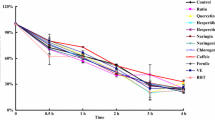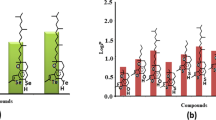Abstract
The antioxidant activity of β-carotene and oxygenated carotenoids lutein, canthaxanthin, and astaxanthin was investigated during spontaneous and peroxyl-radical-induced cholesterol oxidation. Cholesterol oxidation, measured as generation of 7-keto-cholesterol (7-KC), was evaluated in a heterogeneous solution with cholesterol, AAPH, and carotenoids solubilized in tetrahydrofuran and in water, and in a homogeneous solution of chlorobenzene, with AIBN as a prooxidant. The formation of 7-KC was dependent on temperature and on cholesterol and prooxidant concentrations. All the carotenoids tested, exhibited significant antioxidant activity by inhibiting spontaneous, AAPH- and AIBN-induced formation of 7-KC, although the overall order of efficacy of these compounds was astaxanthin > canthaxanthin > lutein = β-carotene. The finding that carotenoids exert protective effects on spontaneous and free radical-induced cholesterol oxidation may have important beneficial effects on human health, by limiting the formation of atheroma and by inhibiting cholesterol oxidation in food processing or storage.






Similar content being viewed by others
Abbreviations
- AAPH:
-
2,2′-Azobis(2-amidinopropane) dihydrochloride
- AIBN:
-
2,2′-Azobis-isobutyronitrile
- COPs:
-
Cholesterol oxidation products
- 7-KC:
-
7-Keto-cholesterol
- THF:
-
Tetrahydrofuran
References
Paniangvait P, King AJ, Jones AD, German BG (1995) Cholesterol oxides in food of animal origin. J Food Sci 60:1159–1174
Morel DW, Lin CY (1996) Cellular biochemistry of oxysterols derived from the diet or oxidation in vivo. J Nutr Biochem 7:495–506
Smith LL (1987) Cholesterol autoxidation. Chem Phys Lipids 44:87–125
Maerker G (1987) Cholesterol autoxidationscurrent status. J Am Oil Chem Soc 64:388–392
Yan PS, White PJ (1990) Cholesterol oxidation in heated lard enriched with two levels of cholesterol. J Am Oil Chem Soc 67:927–931
Chien JT, Wang HC, Chen BH (1998) Kinetic model of the cholesterol oxidation during heating. J Agric Food Chem 46:2572–2577
Bosinger S, Luf W, Brandl E (1993) ‘Oxysterols’: Their occurrence and Biological Effects. Int Dairy J 3:1–33
Kumar N, Singhal OP (1991) Cholesterol oxides and atherosclerosis: A review. J Sci Food Agric 58:267–272
Kowale BN, Rao VK, Babu NP, Sharma N, Bisht GS (1996) Lipid oxidation and cholesterol oxidation in mutton during cooking and storage. Meat Sci 43:195–202
McCluskey S, Connolly JF, Devery R, O’Brien B, Kelly J, Harrington D, Stanton C (1997) Lipid and cholesterol oxidation in whole milk powder during processing and storage. J Food Sci 62:331–337
Nielsen JH, Olsen CE, Jensen C, Skibsted LH (1996) Cholesterol oxidation in butter and dairy spread during storage. J Dairy Sci 63:159–167
Rose-Sallin C, Huggett AC, Bosset J, Tabacchi R, Fay LB (1995) Quantification of cholesterol oxidation products in milk powders using [2H7] cholesterol to monitor cholesterol autoxidation artifacts. J Agric Food Chem 43:935–941
Shozen K, Ohshima T, Ushio H, Koizurni C (1995) Formation of cholesterol oxides in marine fish products induced by grilling. Fish Sci 61:817–821
Zimin P, Evangelisti F, Calcagno C, Tiscomia E (1996) Cholesterol oxidation in dried egg pasta: Detecting 7-ketocholesterol content. Cereal Chem 73:691–694
Ansari GAS, Walker RD, Smart VB, Smith LL (1982) Further investigations of mutagenic cholesterol preparation. Food Chem Toxicol 20:35–41
Gerhardt AL, Gallo NB (1998) Full-fat rice bran and oat bran similarly reduce hypercholesterolemia in humans. J Nutr 128:865–869
Paniangvait P, King AJ, Jones AD, German BG (1995) Cholesterol oxides in foods of animal origin. J Food Sci 60:1159–1165
Watanabe K, Nakamura R, Hosono A (1988) Mutagenic activity of heat-induced cholesterol-degradation products. J Food Sci 38:119–123
Woods JA, O’Brien NM (1998) Investigation of the potential genotoxicity of cholesterol oxidation products in two mammalian fibroblast cell lines. Nutr Cancer 31:192–198
Lyon MA, Brown AJ (1999) 7-Ketocholesterol. Int J Biochem Cell Biol 31:369–375
Kumar N, Singhal OP (1991) Cholesterol oxides and atherosclerosis: a review. J Sci Food Agric 55:497–510
Morel DW, Lin CY (1996) Cellular biochemistry of oxysterols derived from the diet or oxidation in vivo. J Nutr Biochem 7:495–506
Wilson AM, Sisk RM, O’Brien NM (1997) Modulation of cholestan-3â,5R,6â-triol toxicity by butylated hydroxytoluene, R-tocopherol and â-carotene in newborn rat kidney cells in vitro. Br J Nutr 78:479–492
Brown AJ, Jessup W (1999) Oxysterols and atherosclerosis. Atherosclerosis 142:1–28
Lizard G, Monier S, Cordelet C, Gesquiere L, Deckert V, Gueldry S, Lagrost L Gambert P (1999) Characterization and comparison of the mode of cell death, apoptosis versus necrosis, induced by 7β-hydroxycholesterol and 7-ketocholesterol in the cells of the vascular wall. Arterioscler Thromb Vasc Biol 19:1190–1200
Panini SR, Sinesky MS (2001) Mechanisms of oxysterol-induced apoptosis. Curr Opin Lipidol 12:529–533
Emanuel HA, Hassel CA, Addis PB, Berginann SD, Zavoral JH (1991) Plasma cholesterol oxidation products (oxysterols) in human subjects fed a meal rich in oxysterols. J Food Sci 56:843–847
Voutilainen S, Nurmi T, Mursu J, Rissanen TH (2006) Carotenoids and cardiovascular health. Am J Clin Nutr 83:1265–1271
Palozza P, Krinsky NI (1992) Antioxidant effects of carotenoids in vivo and in vitro: an overview. Meth Enzymol 213:403–420
Sies H, Stahl W (1995) Vitamins E and C, ß-carotene and other carotenoids as antioxidants. Am J Clin Nutr 62(suppl):1315S–1321S
Aviram M, Kaplan M, Rosenblat M, Fuhrman B (2005) Dietary antioxidants and paraoxonases against LDL oxidation and atherosclerosis development. Handb Exp Pharmacol 170:263–300
Mayne ST (1996) Beta-carotene, carotenoids, and disease prevention in humans. FASEB J 10:690–701
Niki E (1990) Free radical initiators as source of water- or lipid-soluble peroxyl radicals. Meth Enzymol 186:100–108
Micozzi MS, Brown ED, Edwards BK, Bieri JG, Taylor PR, Khachik F, Beecher GR, Smith JC Jr (1992) Plasma carotenoid response to chronic intake of selected foods and beta-carotene supplements in men. Am J Clin Nutr 55:1120–1125
Palozza P, Krinsky NI (1992) Astaxanthin and canthaxanthin are potent antioxidants in a membrane model. Arch Biochem Biophys 297:291–295
Naguib YM (2000) Antioxidant activities of astaxanthin and related carotenoids. J Agric Food Chem 48:1150–1154
Terao J (1989) Antioxidant activity of beta-carotene-related carotenoids in solution. Lipids 24:659–661
Woodall AA, Britton G, Jackson MJ (1997) Carotenoids and protection of phospholipids in solution or in liposomes against oxidation by peroxyl radicals: relationship between carotenoid structure and protective ability. Biochim Biophys Acta 1336:575–586
Chang YH, Abdalla DSP, Sevanian A (1996) Characterization of cholesterol oxidation products formed by oxidative modification of low density lipoprotein. Free Radic Biol Med 2:202–214
Lizard G, Gueldry S, Sordet O, Monier S, Athias A, Miguet C, Bessede G, Lemaire S, Solary E, Gambert P (1998) Glutathione is implied in the control of 7-ketocholesterol-induced apoptosis, which is associated with radical oxygen species production. FASEB J 12:1651–63
Chen BH, Chen YC (1994) Evaluation of the analysis of cholesterol oxides by liquid chromatography. J Chromatogr A 661:127–136
Palozza P, Serini S, Di Nicuolo F, Boninsegna A, Torsello A, Maggiano N, Ranelletti FO, Wolf FI, Calviello G, Cittadini A (2004) beta-Carotene exacerbates DNA oxidative damage and modifies p53-related pathways of cell proliferation and apoptosis in cultured cells exposed to tobacco smoke condensate. Carcinogenesis 25:1315–1325
Kim SK, Nawar WW (1993) Parameters influencing cholesterol oxidation. Lipids 28:917–22
Chien JT, Hsu DJ, Chen BH (2006) Kinetic model for studying the effect of quercetin on cholesterol oxidation during heating. J Agric Food Chem 54:1486–1492
Lee HW, Chien JT, Chen BH (2006) Formation of cholesterol oxidation products in marinated foods during heating. J Agric Food Chem 54:4873–4879
Nielsen JH, Olsen CE, Skibsted LH (1996) Cholesterol oxidation in a heterogenous system initiated by water-soluble radicals. Food Chem 1:33–37
Xu Z, Hua N, Godber JS (2001) Antioxidant activity of tocopherols, tocotrienols, and gamma-oryzanol components from rice bran against cholesterol oxidation accelerated by 2,2′-azobis(2-methylpropionamidine) dihydrochloride. J Agric Food Chem 49:2077–2081
Lim BP, Nagao A, Terao J, Tanaka K, Suzuki T, Takama K (1992) Antioxidant activity of xanthophylls on peroxyl radical-mediated phospholipid peroxidation. Biochim Biophys Acta 1126:178–84
Woodal AA, Lee SW, Weesie RJ, Jackson MJ, Britton G (1997) Oxidation of carotenoids by free radicals: relationships between structure and reactivity. Biochim Biophys Acta 1336(1):33–42
Schroepfer GJ (2000) Oxysterols: modulators of cholesterol metabolism and other processes. Physiol Rev 80:361–554
Dzeletovic S, Breuer O, Lund E, Diczfalusy U (1995) Determination of cholesterol oxidation products in human plasma by isotope dilution-mass spectrometry. Anal Biochem 225:73–80
Raith K, Brenner C, Farwanah H, Muller G, Eder K, Neubert RH (2005) A new LC/APCI-MS method for the determination of cholesterol oxidation products in food. J Chromatogr A 1067:207–211
Acknowledgment
This work was supported by MIUR.
Author information
Authors and Affiliations
Corresponding author
Rights and permissions
About this article
Cite this article
Palozza, P., Barone, E., Mancuso, C. et al. The protective role of carotenoids against 7-keto-cholesterol formation in solution. Mol Cell Biochem 309, 61–68 (2008). https://doi.org/10.1007/s11010-007-9643-y
Received:
Accepted:
Published:
Issue Date:
DOI: https://doi.org/10.1007/s11010-007-9643-y




